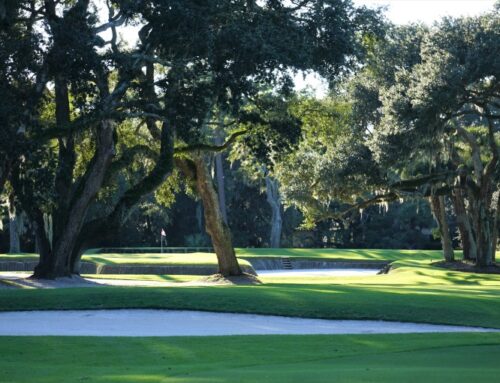Farmington Country Club
Virginia, United States of America
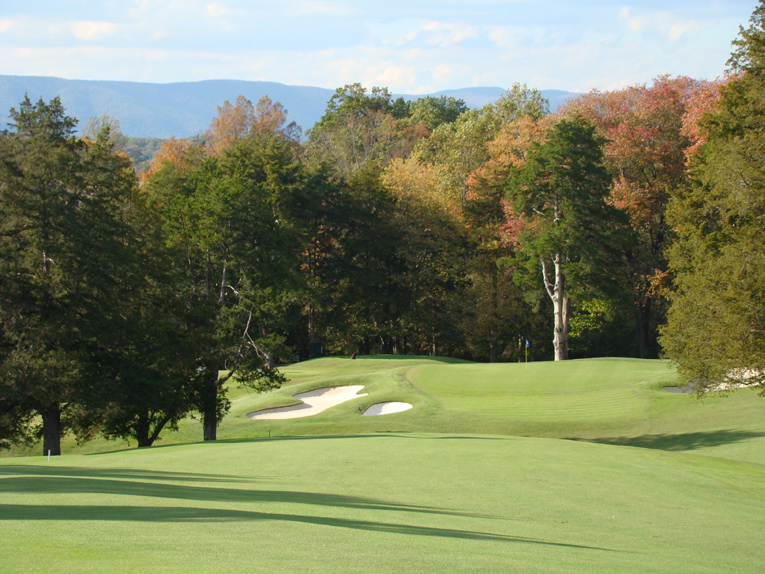
Set in the foothills of the Blue Ridge Mountains, Farmington has an ambience all its own that is hard to beat.
The word ‘genius’ is grotesquely over-used on a day-to-day basis but when true genius is recognized it is quite awe-inspiring. That point is made abundantly clear when visiting Charlottesville, Virginia where Thomas Jefferson’s shadow looms large. Jefferson was a scientist, patriot, architect, politician and bon-vivant. His home at Monticello is noteworthy on several levels and the concept of the college campus began with Jefferson’s work at The University of Virginia where he situated buildings around an open area that became known as The Lawn. Before designing the University of Virginia (which he did in ‘retirement’ at age 76!), Jefferson’s life was based in public service and included such minor things as the drafting of the Declaration of Independence, crafting the Louisiana Purchase, the role of third President of the United States, and pushing the Lewis & Clark expedition. Now that’s a genius!
Given the power of Jefferson’s creations, design in Charlottesville is no small matter. Critical eyes are prevalent and standards high. In 1927 Fred Findlay laid out Farmington Country Club near such monuments to design. Perhaps he was inspired by both Jefferson and the setting as Farmington stands out not only as his masterpiece but perhaps the best golf course in the state. Born in 1872, Fred Findlay grew up in Montrose, Scotland and was younger than his more famous brother Alex. By any measure, Fred was a supremely talented golfer; he moved to Australia where he became the head golf professional at the Metropolitan Golf Club. After his sixteen year old son tragically died, his wife returned to Scotland with the casket in 1912. Findlay and his daughter Ruth remained in Australia where she met and fell in love with an American, Raymond Loving. The two married in 1924 in Australia before Loving moved them to his Charlottesville home. Findlay accepted the offer to join them and spent the rest of his life there. (On a side note, Ruth and Raymond had a girl and a boy, Buddy Loving, who learned golf course architecture from his Scottish grandfather and eventually started his own firm. Like Findlay, Loving’s work is concentrated in the Mid-Atlantic states.)
Findlay must have felt quite at home in Charlottesville, where the Blue Ridge Mountains surely reminded him of the Cairngorms. Located west of Montrose, this national park includes the biggest mountain ranges in Britain as well as its tallest peak. Charlottesville’s forests and rivers were also reminiscent of Findlay’s Scotland. After his son’s death in 1912 and his wife’s departure, the next dozen years were surely ones of anguish but the move to America signified a fresh start. In short order, he helped the spread of golf in this part of the world. His work at the James River Golf Course at The Country Club of Virginia in Richmond and Boonsboro Country Club in Lynchburg showed a flair for golf course architecture. Along with Farmington these stand as his finest designs. Farmington, though, is his undoubted masterwork in part because it was built on a superior site and in part because he had the luxury of refining his design over several decades. He ended up living above a garage on the club property and passed away at the ripe age of 94 in 1966.
Findlay’s routing and sequencing of holes at Farmington is exemplary. Holes weave through valleys and up, over and around diverse landforms. The shortish two shot first works the kinks out, the golfer gets a peek at the mountain range at the second before tackling the difficult third whose fairway falls off the shoulder of a hill. The fourth and fifth are in their own valleys from which the sixth ascends. Standing on the seventh tee, the golfer is at the high point of the property. The remainder of the front nine is played over long broad slopes before the golfer confronts the beastly one shot tenth. Now the golfer is in the woods for a counterclockwise loop of three holes with nice undulations before playing the final five holes that loop clockwise with the low point of the property reached at the penultimate hole.
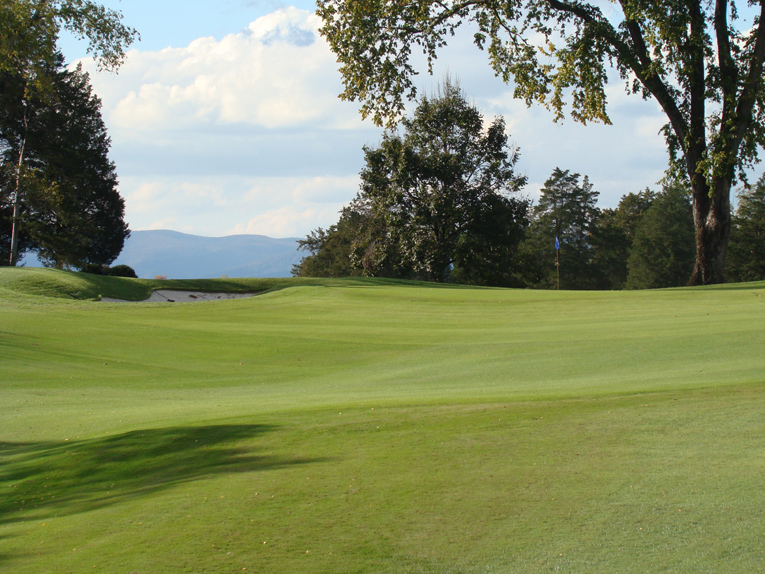
Farmington’s special environment is hinted at behind the second green. Note Findlay’s clean lines as he knew well enough not to clutter the proceedings with mounds or anything else that would distract the eye from what nature provided.
The spacing of the landforms as captured by Findlay’s routing is nearly perfect. The rhythmic down and up nature of the holes pose a variety of shots requirements, and continually expose the golfer to the vagaries of the tumultuous terrain. Indeed, fierce man-made hazards aren’t the primary challenge at Farmington. Let’s face it: sandy contrivances known as bunkers have no natural basis in foothills. Rather, the heart of the golfer’s challenge at Farmington is how he handles its sloping fairways and pitched greens.
Unfortunately, Findlay left behind nothing in his own words to help guide us through his design process at Farmington (or for any of his other courses). We turn instead to Richard Findlay, his nephew, for insight into Fred and his work. In the July, 2012 Feature Interview on GolfClubAtlas.com, Richard described Farmington as follows:
My great Uncle Fred not only was a great golfer but also quite a landscaper in his own right. I had the privilege of meeting Fred in 1963 at Farmington, he was a lovely man, sharp of mind and he loved to paint. His daughter Ruth would provide him with all the canvass he could handle and he would paint scenes from his home in Scotland, where his heart remained. I think he loved Charlottesville because it reminded him so much of Scotland. There is one of his paintings hanging in the Thomas Jefferson building at Farmington. I have played Farmington a few times and I must admit it is also one of my favorite courses in the United States. Of course, even to this day it is still very private but extremely well maintained. When Fred came to the U.S. following his daughter in her marriage to Raymond Loving he ended up in Charlottesville, VA. He would spend the next 40 years there building golf courses throughout the mid-Atlantic states. Whereas Alex concentrated on courses north of the Mason Dixon, Fred went south. Like Alex who taught his trade to his son Norman, Fred taught his grandson Buddy Loving the business. Between the two of them close to a hundred courses were designed and constructed. As for comparing one against the other is something another person will have to do. Alex taught Fred the business and started him out building courses. They worked together and did a magnificent job in doing so. I guess when you compare Fred’s courses to Alex’s, how do they stand the test of time? Alex had two of his designs host major championships, Fred’s courses, although not hosting any majors, did host state championships as well as numerous regional tournaments. Living here in Richmond, VA, you cannot throw a rock and not hit a Findlay or Loving design. One thing about Farmington Country Club is the landscaping surrounding the course, after all Fred was equally concerned with landscaping as he was with doglegs.
Standing on such tees as the seventh and fourteenth, the golfer really appreciates Richard’s point about Farmington reminding Fred of his beloved Scotland. Indeed, Findlay was so moved that he began painting with oil, alternating between scenes from his childhood in Scotland and his new found home near the blue hued mountains.

Above is Fred Findlay’s handsome oil painting of the third hole at Farmington. It resides in the clubhouse.
The good golfer enjoys the challenge of placing his ball into favorable positions on a golf course. At Farmington such success offers opportunities for good scoring but indifferently played shots will often find undesirable slopes and consequently an awkward next shot. Perhaps the golfer gets shoved right off the sloped third fairway into trees, is left with a hanging lie right at the fourth or scuffs his second from a sloping lie down into the valley at the sixteenth. In all these circumstances, the golfer still has a fighting chance though the ensuing shot will be uncommonly difficult. Placing one’s ball properly and avoiding such pitfalls is intensely satisfying. One nice thing about this sort of golf is that you may well begin and end the round with the same ball. Tall, thick rough is non-existent and the depth of its bunkers isn’t overly penal; the challenge here is strategic.
Jefferson once wrote, “Walking is the very best exercise. Habituate yourself to walk very far.” No doubt, Jefferson had the heart of a true golfer (!) and a walk around the well-maintained grounds at Farmington is something that every golfer would relish as we see below.
Holes to Note
Third hole, 445 yards; The hole’s enduring qualities result from the unconventional manner in which Findlay utilized the land forms. Set at nearly a 45 degree angle to the tee, the fairway cascades down the spine of a domed ridge line. All sorts of unfavorable stances are served up and the pushed up green at the end offers little respite. This is an original and surely one of the first great holes built in the state of Virginia; no surprise that it came from a Scot with an innate feel for the values of good golf. Farmington’s highly regarded Green Keeper Scott Kinnan delights in pointing out one of the course’s most subtle features, namely that this green actually runs slightly from front to back. Study the photograph of the green below as much as you want; you’ll never convince yourself of that fact until you see approach after approach head toward the back of the green.

Findlay’s varied use of the land is what makes Farmington a pleasure to play time and time again.

The third green is an elusive target from well back in the fairway from a hanging lie.
Fourth hole, 375 yards; Courses set in the foothills near mountain ranges offer their own unique characteristics, one of which is a creek running through a valley. And that’s what we find here, with Findlay using it to perfection by placing the fairway on one side of the creek and the green on the other.
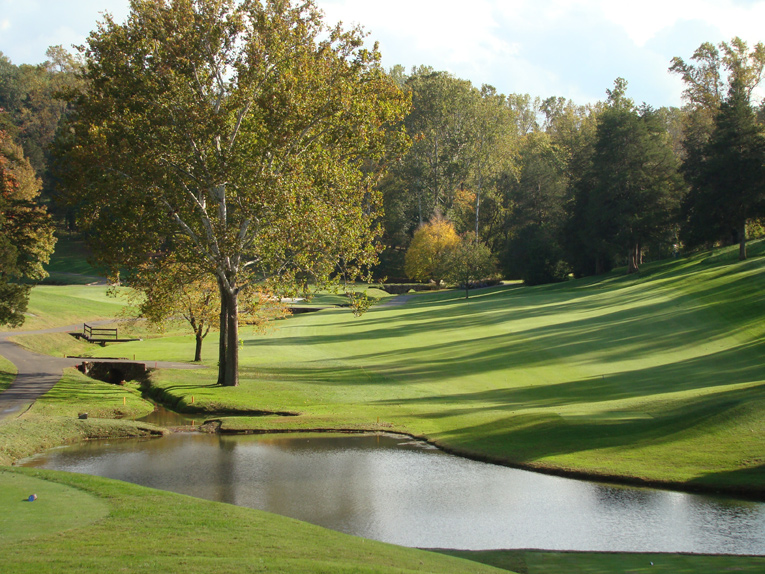
Though the broad slopes at Farmington can be the golfer’s undoing, they can also be of great help. A draw off the fourth tee dutifully kicks left and finds the flat portion of the fairway along the left side that is guarded by the creek. From that advantageous position, the golfer enjoys the best approach angle down the length of the green.

Conversely, if the tee ball comes to rest on the high right side, the golfer is left with an awkward stance from which to cross the creek.
Fifth hole, 455 yards; Findlay takes us up the valley wall with this beefy two shotter. In fine contrast to the prior hole where the creek was to the left, here it is on the right. Similar to all Golden Age designs, an uphill green such as this one is sharply tilted toward the golfer, creating a goal of keeping the ball beneath the hole. A golfer who finds his approach to the sides of greens like this and the Home green is courting sure misery.
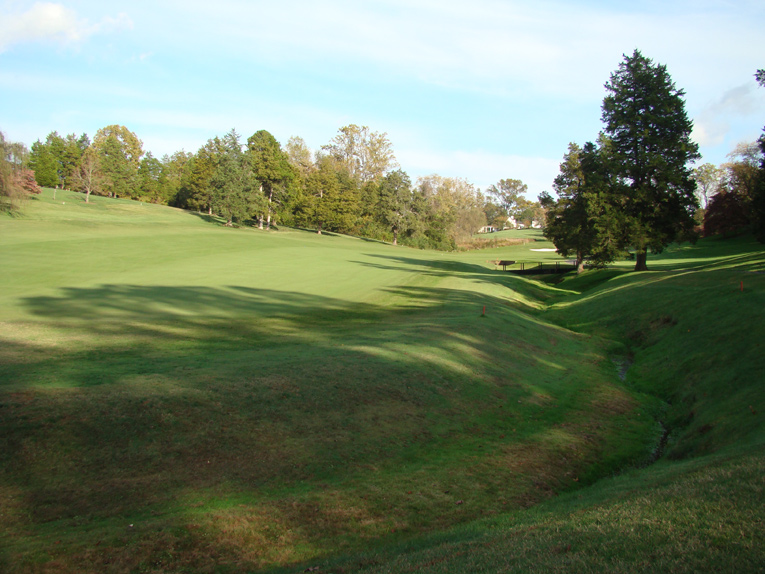
Just as it was advantageous on the last hole to hug the creek, so it also is at the fifth whose fairway bends to the right past this ditch. This is the number one handicap hole and those who steer too far left are unlikely to reach the green in regulation.
Seventh hole, 505 yards; The absence of long views dampen the exhilaration of golf played on inland courses relative to links or heath land. Yet, from the two high points on the course (here and the fourteenth tee) such banalities fade away. The sight of a well-struck tee ball bounding along the fairway 50 feet below is guaranteed to bring a smile to even the most jaded, well-traveled golfer. Kinnan notes, ‘The soils at Farmington are predominately clay to loam. We are fortunate to have these typically deep soils in what can be a very rocky area. Though prone to compaction, the soil is outstanding with regard to drainage. Due to the topography and soils on the course, there are very few areas where drainage is a significant concern so we are able to achieve firm playing surfaces throughout. Making sure that tee balls run along these sloped fairways is a vital element in having the course play properly.’

A majestic 1/2 par hole, the seventh provides an important respite near the middle of Farmington’s difficult stretch from the fifth through the eleventh holes. Though it may be the easiest hole on the course relative to par, the seventh is also a favorite of many with enough punch to keep every skill set of player honest.

Going for this green in two is great fun but not without peril. Short finds the hazard while the bank behind the green might be worse!
Eighth hole, 435 yards; In some ways, the eighth is a microcosm for Farmington as it doesn’t reveal all its secrets at first. The more you play it, the more fun and interesting it becomes. The tee shot plays from one hill to another on the most open, vast part of the course. As such, the wind changes the complexion and difficulty of the hole more than any other. A ridge running diagonally across the fairway is the key: Drive left near the inside of the dogleg and your tee ball is likely to get a kick down the slope, leaving but a short or mid iron. Steer right and be left with a longer, possibly blind second shot with a utility club. One can’t overstate the difference in coming into this terrific green with a utility club vs. a short iron. There is no easy hole location here, with the sharp downhill slope and a right to left bend across the green, enhanced by several mini-plateaus that can create difficult reads.
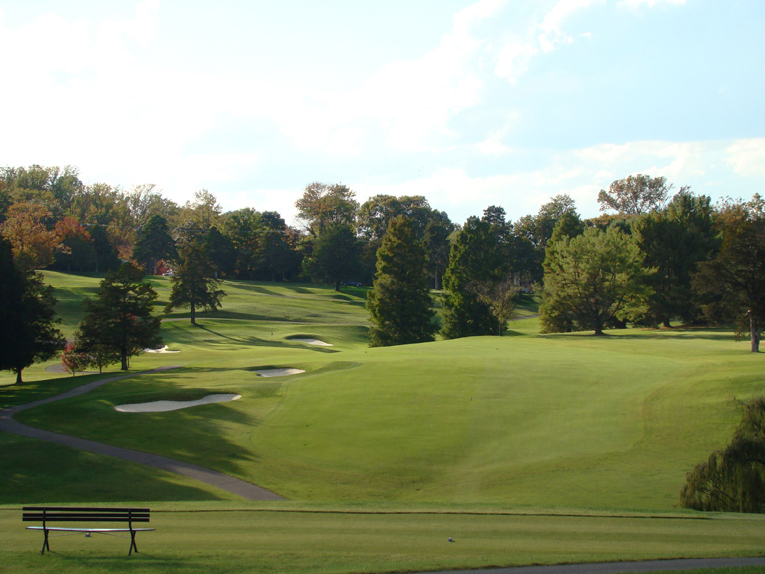
Interesting land can produce varied results and such is the case off the eighth tee. Tee balls played right tend to stay on top of the plateau while a draw down the left gets propelled to a lower section of the fairway, leaving a much shorter approach shot.
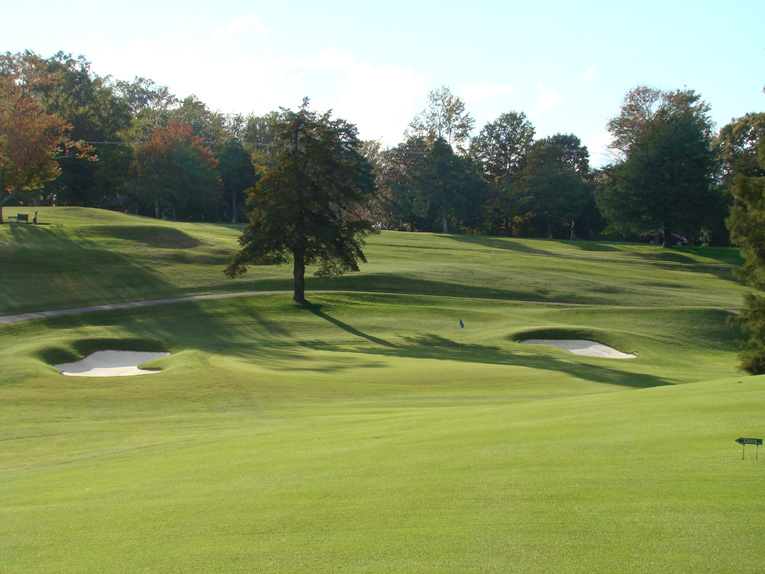
The green site, tucked in a swale in the land and sitting up in the front, falls nearly four feet from back to front. A front right hole location just over an innocent looking but devilish false front is especially difficult.
Ninth hole, 415 yards; Farmington isn’t overly long at 6,725 yards but it plays appreciably longer because the numerous upslopes attenuate the tee ball. This becomes especially problematic at the fifth, ninth and eighteenth holes, all long two shotters. The bottom line is that the course still has what it takes to test the best amateurs.
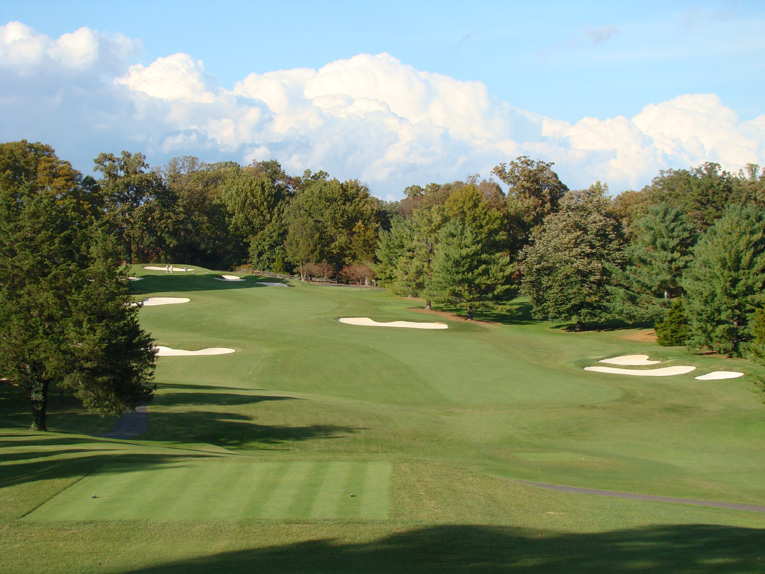
The staggered bunker scheme visually breaks up the ninth fairway’s long gradual upslope while lending playing interest.
Tenth hole, 250 yards; As is evident from the photographs on the prior page, Farmington is a spacious course. Yet having just concluded play across the most open portion of the property, the golfer now steps on the tee of the only hole that might be construed as, well, less than spacious. Out of bounds lurk close by on the left in the form of the main club road and another auxiliary road. Cruelly, the green is both narrow and long. Restraint is often difficult for the modern player but he would be wise to summon some here. Select a club that might enable one’s tee ball to crawl onto the very front edge of the putting surface but no more. Even better to emulate Billy Casper who famously tamed the third at Winged Foot and be content with a five or ten yard pitch to the putting surface. At the end of the year, you’ll find that your prudence has saved you strokes.
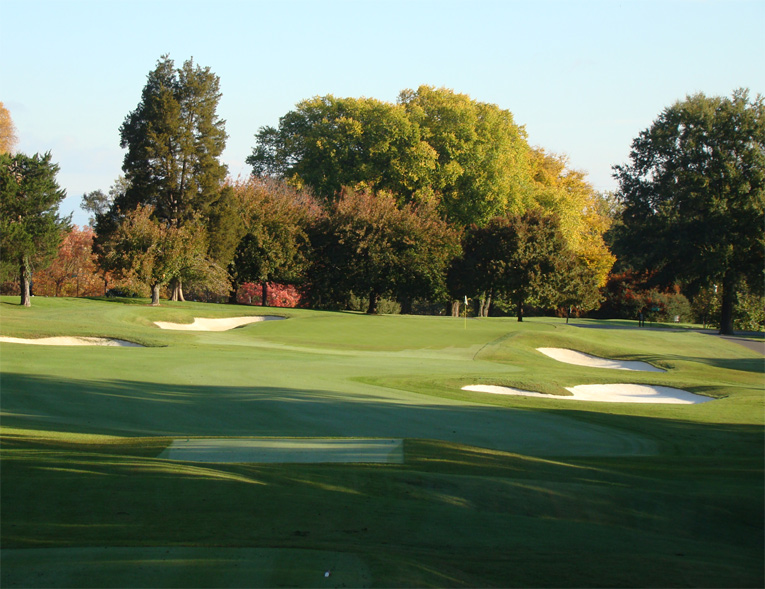
The tenth has been considered for decades among Virginia’s best one shot holes. Out of bounds is just to left of the photograph and activity from the main club road may unsettle the golfer, especially if he is standing on the tee holding a balky driver.
Eleventh hole, 425 yards; Many of Findlay’s greens are located on high spots with putting surfaces sloped from back to front. At this sharp dogleg left, the green complex is actually built on the downward side of the hill. As such, the natural slope for the putting surface should be to continue the same grade as the surrounding land. And guess what? That’s what Findlay did with this green falling away from the golfer from front to back.
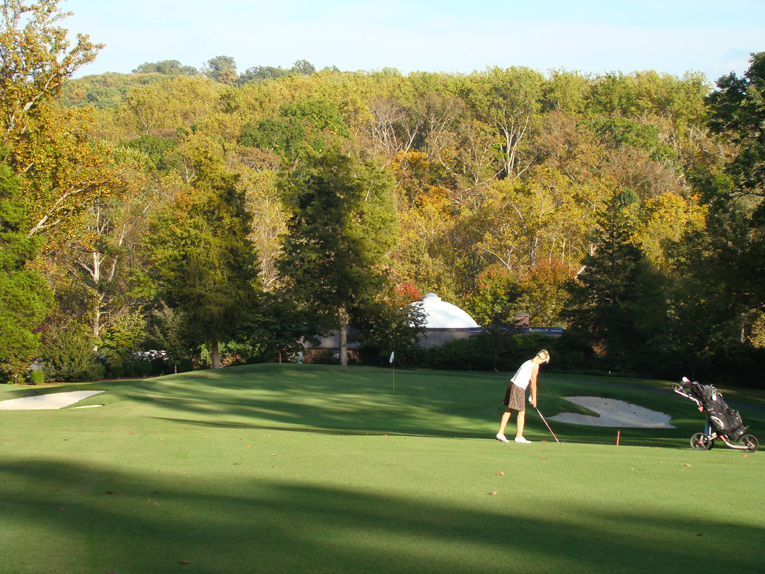
The downhill view to the green can be maddening as you watch your approach shot roll and then continue rolling along the front to back sloping green.
Thirteenth hole, 310 yards; Great short two shotters have the ability to produce a wide variety of outcomes; that’s what makes them so exciting. At a recent Kenridge Invitational (Farmington’s highly regarded amateur event now in its seventy-sixth year), a decorated amateur champion five putted from less than twenty feet for triple bogey while a collegian made a hole in one for a double eagle from the Sunday forward tees from where the hole plays 265 yards (i.e. just slightly longer than the tenth). A 1 and a 7 by players of similar skill – such is life at the thirteenth! Interestingly enough, this hourglass green with a ridge in the middle is the largest putting surface on the course at 7,840 square feet. Yet, the left and right sections of the green each plays effectively small. Tales of horror dominate the Grill Room from various mis-adventures suffered here. Be content with finding the fairway with a utility club, a short iron to the correct section and two putts.
Fourteenth hole, 465 yards; There are trees at Farmington and the last three holes could be deemed ‘tree lined’ but the ten mile view from the fourteenth tee toward Buck Mountain belies this characterization. Farmington is not so easily classified. Is it a parkland course? Mountain? What? No matter – it is unique which helps it gain a special spot in one’s memory.
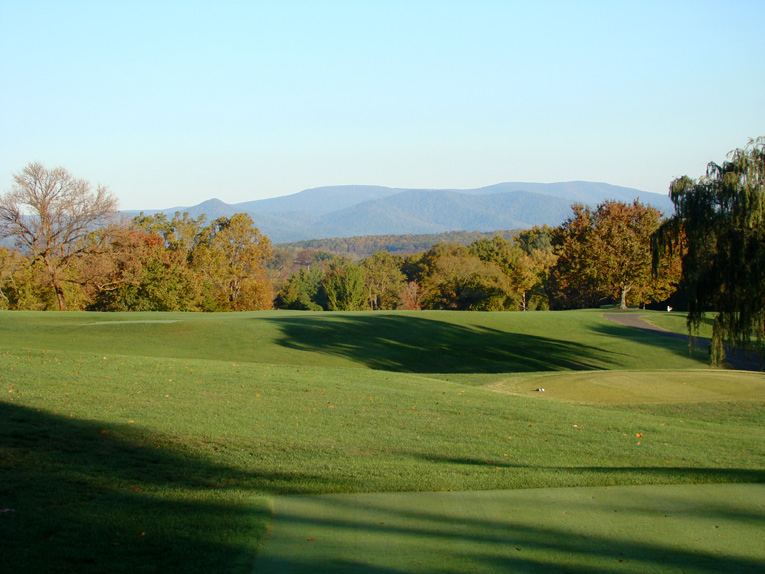
The full glories of a round at Farmington are on display from the fourteenth tee.
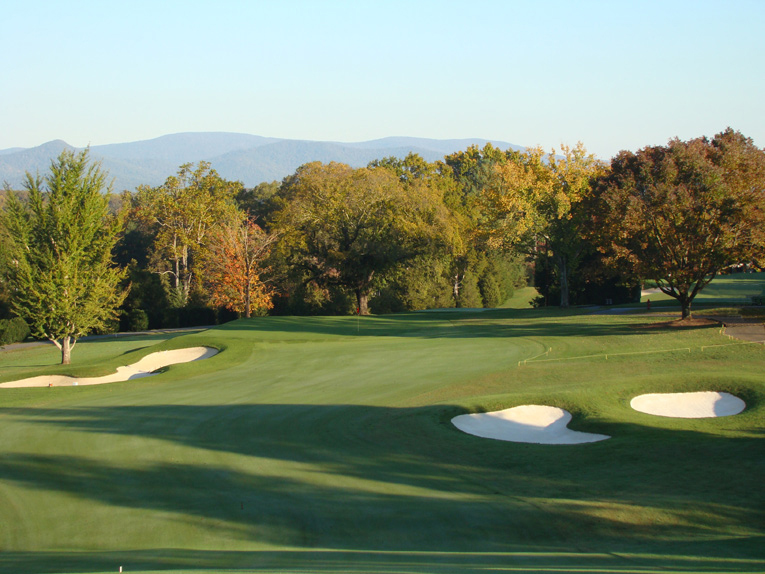
The fourteenth features the most undulating fairway on the course and the distance for one’s approach can vary widely based on the first several bounces that the tee ball receives.
Sixteenth hole, 560 yards; Farmington only has two par fives and Findlay should be congratulated for making them so different. The first one (the seventh hole) features a long view to the green and was reachable even in the days of hickory golf. In fine contrast, the sixteenth is a daunting three shotter. A solid poke is required to reach the edge of the dogleg left and another one to cross a ravine (and this shot is played from a sloping stance). The green comes into view only after two well played shots.
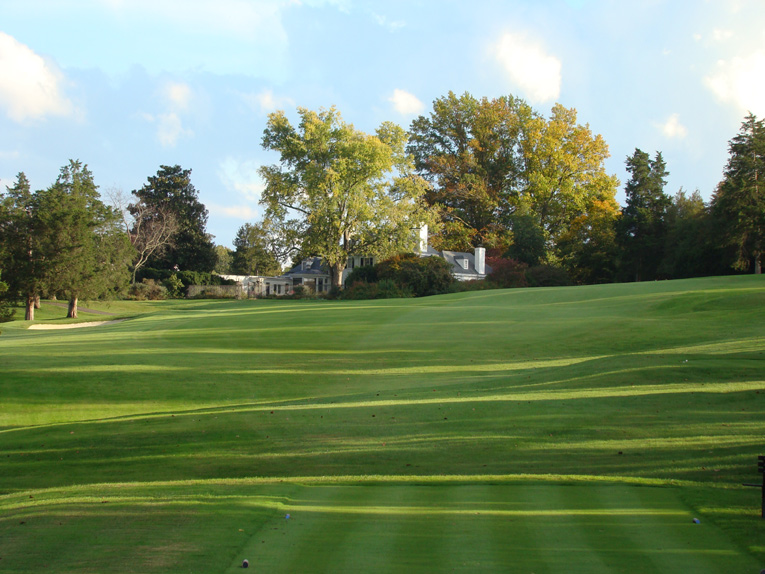
Advancing the ball well down the fairway off the sixteenth tee is essential for the golfer to entertain …

… carrying this ravine with his second. Findlay’s routing around this depression makes the hole.
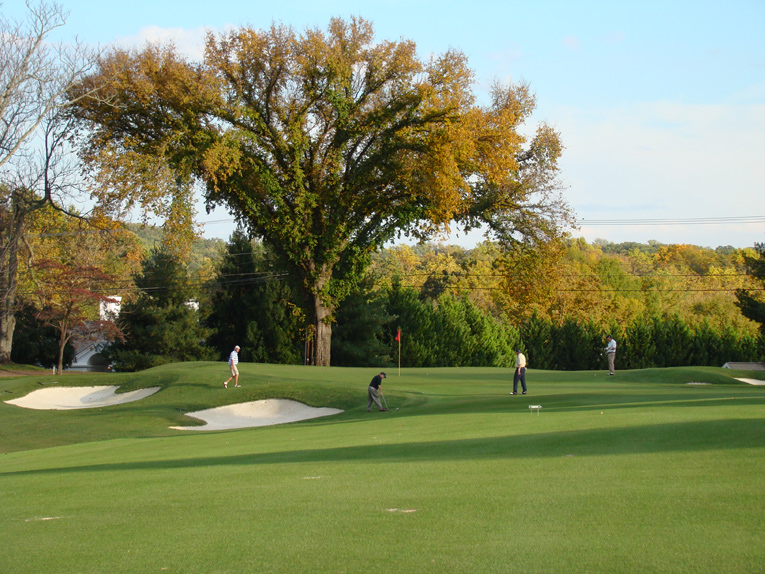
The only solace is that the sixteenth green is relatively large and is open front right which allows for a running shot from well back in the fairway.
Seventeenth hole, 185 yards; Facing a one shooter as the penultimate hole is nothing new. Famous ones abound, some with water (TPC-Sawgrass) and others with greens even more fiercely protected (Sand Hills). No other in the author’s experience plays so precipitously downhill and the rub here is that nothing prior in the round prepares the golfer to calibrate the required shot. In addition, this is far and away the smallest target on the course at 4,550 square feet. The screws are on as this steeply pitched green begs for the tee ball to be positioned below the day’s hole location. As is true at so many nuanced courses from the Golden Age of architecture, bet on the local if the match gets to this late stage.
Eighteenth hole, 415 yards; The most manufactured tee complex is handsomely benched into a steep hillside and serves as another reminder to the golfer that he is playing in the foothills of the Blue Ridge mountains. Even more evidence is provided ahead in the fairway where level stances are rare. The uphill green features the deepest greenside bunkers on the course, putting a premium on the day’s last full shot.
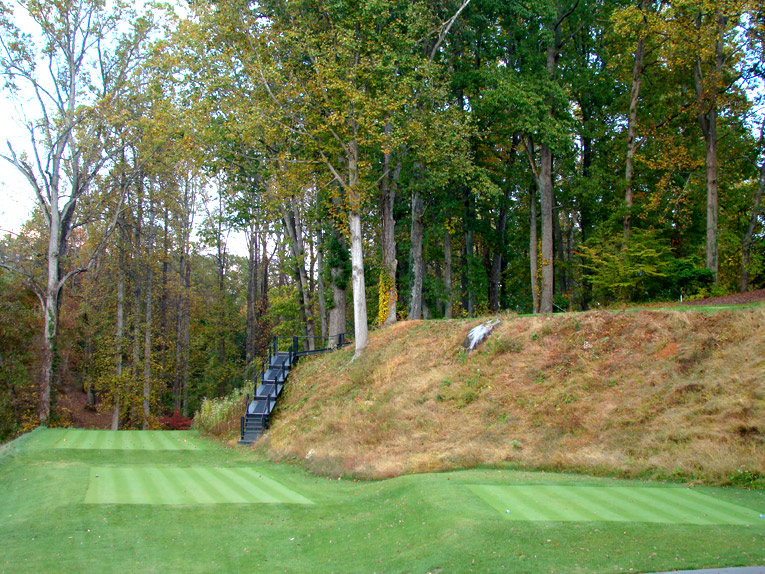
Looking back at the eighteenth tee, Findlay’s orginal tee is high on the right from where the hole plays 385 yards. A new tee was added recently by architect Bill Love that stretched the hole an additional ~30 yards. These were important yards as it gives the course the sort of challenging finish that Findlay intended.
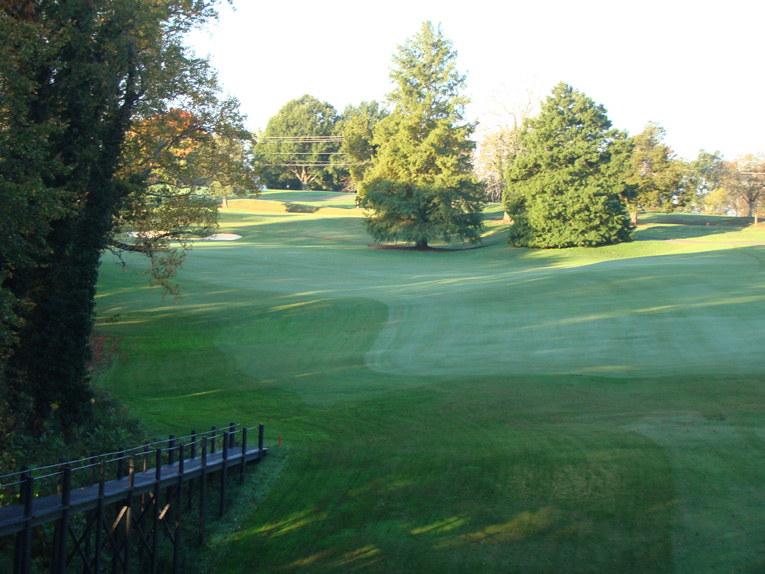
Where there is a bridge, there is topography. Such is most certainly the case at the Home Hole at Farmington which climbs uphill all the way to the green.
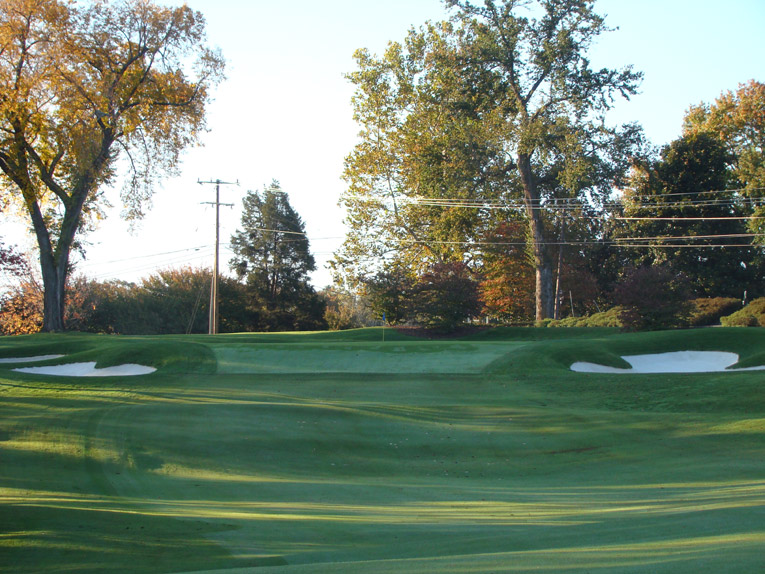
The Home green features a false front more blatantly wicked than the one at the eighth. Many a ball has reached the elevated green only to end up unceremoniously down the hill some ten to twenty yards.
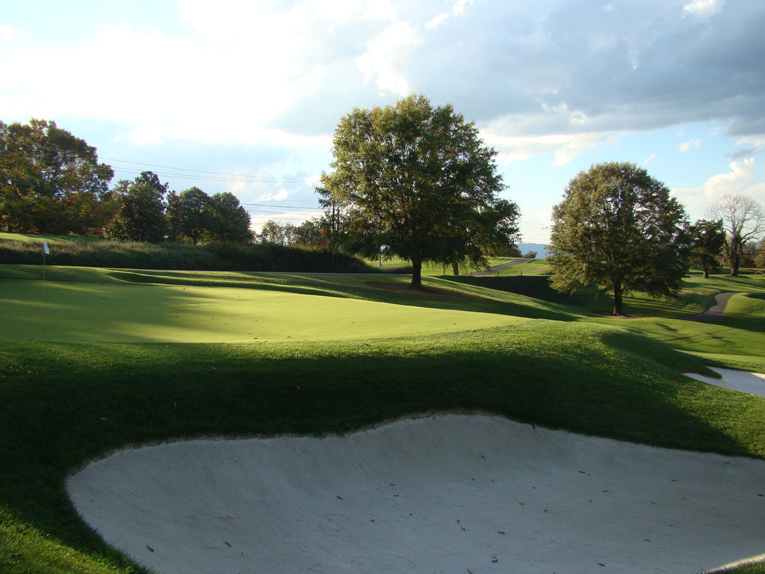
As seen from the left, one gains a sense of both the back to front tilt of the putting surface as well as the greenside bunker depth.
Holing out, the golfer is near the east wing of Farmington Country Club, designed by Jefferson. Built in 1802, there is no mistaking his work as the octagon is a design element that he frequently employed. Sitting nearby on the north patio of the clubhouse is the perfect spot to have a refreshment after one’s round as the view of the Blue Ridge mountains in the distance is captivating. Upon reflection the golfer appreciates that Findlay took him on quite a journey, laying out the holes in all sorts of manners around interesting landforms. The golfer is continually challenged to make the necessary adjustments to his stance to successfully find the greens whose slopes reflect their surrounds. Just as in Findlay’s day, successful play is about guile and cunning rather than brute force. In this manner, all age groups find enjoyment here. Indeed, Farmington has produced more fine women players than any other club in the state. Also, for those that shrewdly elect to retire to Charlottesville, Farmington is well nigh the perfect course on which to grow old. Look no further than Findlay who played the course up until his death at age 94. His body is interred at the nearby Monticello cemetery.
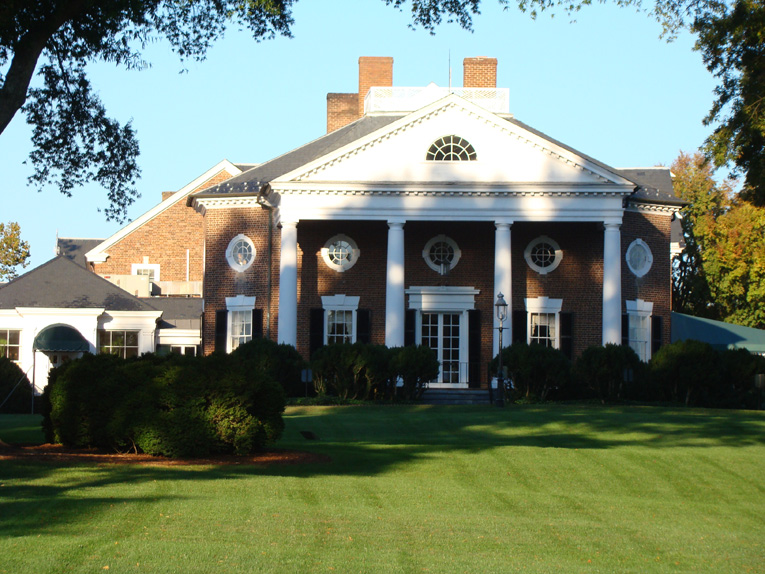
The east wing of the clubhouse that Thomas Jefferson designed is two hundred yards from the eighteenth green.
For many good reasons, Jefferson was enamored with Monticello. Located less than ten miles from Farmington, the two properties feature many of the same commanding views. Jefferson wrote the following over two hundred years ago:
“And our own dear Monticello, where has nature spread so rich a mantle under the eye? Mountains, forests, rocks, rivers. With what majesty do we there ride above the storms! How sublime to look down into the workhouse of nature, to see her clouds, hail, snow, rain, thunder, all fabricated at our feet! And the glorious Sun, when rising as if out of a distant water, just gliding the tops of the mountains, and giving life to all nature!”
Those same elements that moved Jefferson many years ago remain grandly displayed at Farmington Country Club. Findlay’s handiwork highlights them in a manner that enchants today’s golfer just as they did our venerable third president.
The End



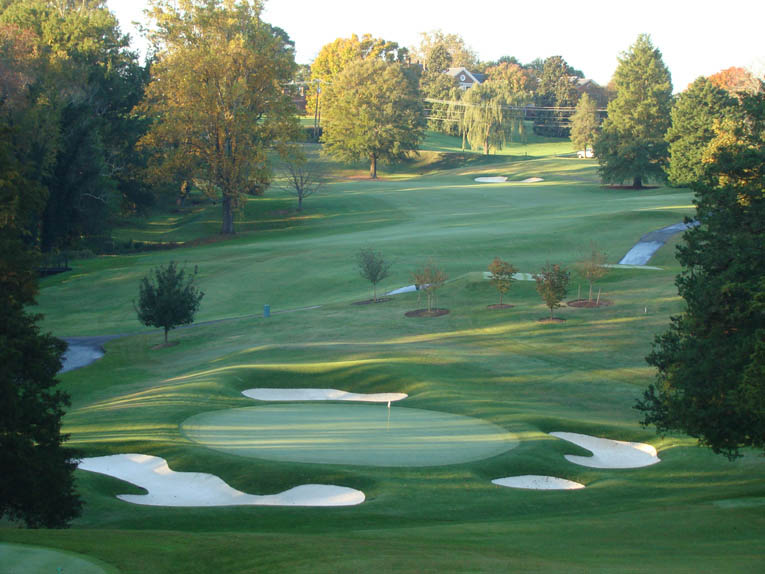


![The Park, West Palm (Lit 9) [2023]](https://golfclubatlas.com/wp-content/uploads/2024/12/IMG_7092-2-scaled-500x383.jpg)



